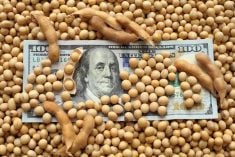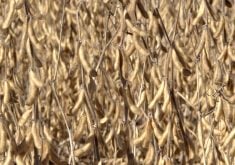CNS Canada — Canola futures don’t appear ready to climb drastically higher anytime soon as uncertainty over Chinese buying weighs on the market, according to a Winnipeg trader and analyst.
The recent grain stocks report compiled by Statistics Canada has become a source of pressure for canola, said Ken Ball of PI Financial.
StatsCan’s report was released last week and pegged canola stocks in Canada as of July 31 at 2.06 million tonnes, a figure higher than expected. The report coincided with an unexpected upward revision to the 2015 canola production total.
Read Also

China to buy 12 million metric tons of soybeans this season, Bessent says
U.S. Treasury Secretary Scott Bessent said on Thursday that China has agreed to buy 12 million metric tons of American soybeans during the current season through January and has committed to buying 25 million tons annually for the next three years as part of a larger trade agreement with Beijing.
On top of that, there is also uncertainty over how China will deal with future exports of Canadian canola. Beijing at the 11th hour put off plans to lower the amount of dockage allowed in shipments of Canadian canola.
While business continues between the two countries, it has created a source of uncertainty for investors.
“The China situation becomes very critical right now depending on how it evolves,” said Ball, adding large commercial groups are likely hesitant to get locked into heavy orders for fear of getting caught by a sudden rule change.
“Unless beans are pointed lower, we’re getting down to the point where we could be getting close to putting in some fall lows,” he added.
The Canadian dollar has been weaker of late, which cushioned the blow from supply concerns.
During the week ended Wednesday, the front-month canola contract at ICE Futures Canada lost $1.80 per tonne, to finish at $457.60.
“If it wasn’t for the Canadian dollar action we’d probably be looking at $440 (per tonne) right now,” said Ball.
However, he said, currencies “tend to swing back and forth” so the softness in the dollar could be temporary.
StatsCan next week is scheduled to release its second annual model-based principal field crop estimates. The report debuted in 2015 and drew a lot of attention. Rather than using surveys with farmers to arrive at its conclusions, the report incorporates coarse resolution satellite data from StatsCan’s crop condition assessment program.
The report, StatsCan said, also takes information from the agency’s Field Crop Reporting series and agroclimatic data.
Ball said the report is interesting, but he’s not sure how many stakeholders will pay close attention to it.
— Dave Sims writes for Commodity News Service Canada, a Winnipeg company specializing in grain and commodity market reporting.











